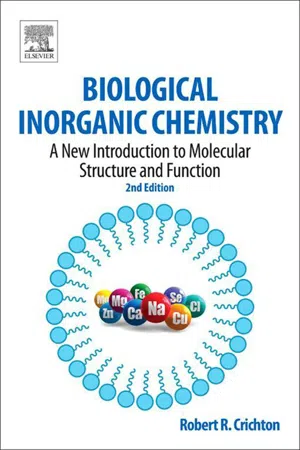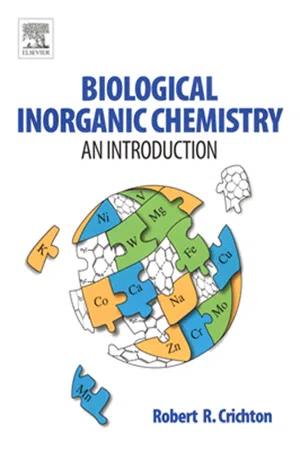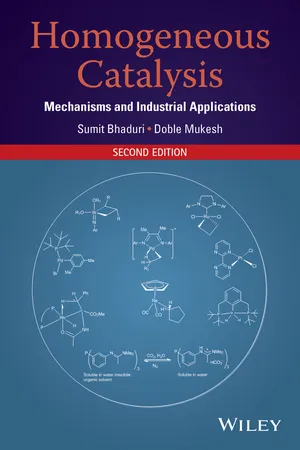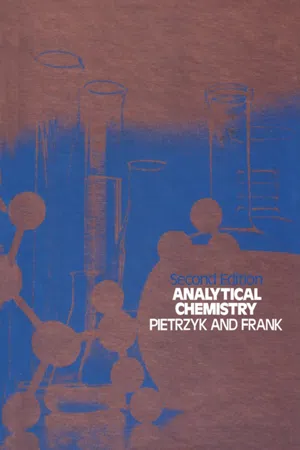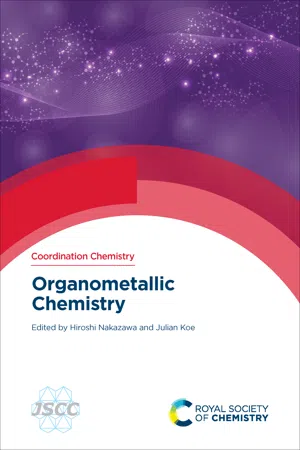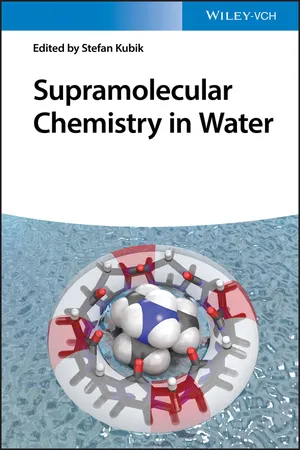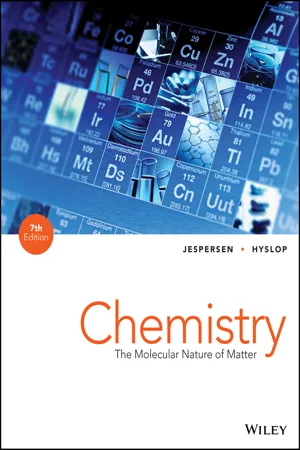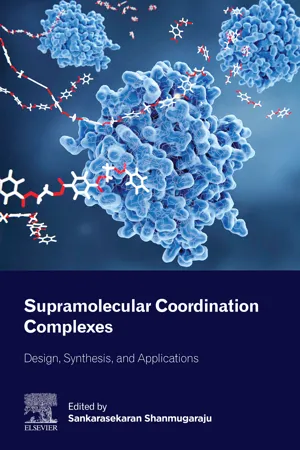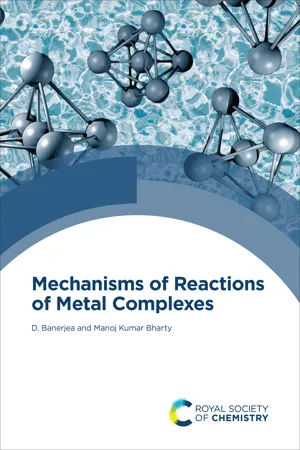Chemistry
Coordination Compounds
Coordination compounds are molecules that consist of a central metal atom or ion bonded to surrounding molecules or ions, known as ligands. These ligands donate electron pairs to the metal, forming coordinate covalent bonds. Coordination compounds often exhibit unique properties and are widely used in fields such as catalysis, medicine, and materials science.
Written by Perlego with AI-assistance
Related key terms
Related key terms
1 of 4
Related key terms
1 of 3
11 Key excerpts on "Coordination Compounds"
- eBook - ePub
Biological Inorganic Chemistry
A New Introduction to Molecular Structure and Function
- Robert R. Crichton(Author)
- 2012(Publication Date)
- Elsevier(Publisher)
2 . Most compounds, however, contain atoms of different elements, which have different electronegativities and, hence commonest type of bonding lies somewhere between purely ionic and purely covalent as in HCl.Coordinate bonds are a special case of covalent bonds where the electrons for sharing are supplied by one atom. There is often a fractional positive charge on the donor atom and a fractional negative charge on the acceptor atom. CoBr3 ·3NH3 (Figure 2.2 ) exhibits this type of bonding and hence traditionally it is referred to as a coordination compound.FIGURE 2.2 Structure of the coordination complex CoBr3 ·3NH3 .Coordination3 compounds consist of a central atom or ion, like Co3+ , surrounded by electron-rich groups (ligands), like NH3 . The ligands are directly bound (coordinated to) to the central atom or ion, they are usually between 2 and 9 in number and may be single atoms, ions, or molecules. The ligands directly bound to the metal are said to be in the inner coordination sphere, and the counter-ions that balance out the charge are said to be outer sphere ions. Coordination Compounds are usually referred to as complexes, they can be charged or uncharged and their structure is defined by the coordination number (the number of ligand atoms bonded to the central atom) and their coordination geometry (the geometrical arrangement of the ligands and the symmetry of the entire complex). The central ion can be in any oxidation state, which remains unchanged in the coordination complex. We shall endeavour in what follows to explain some of the concepts of coordination chemistry and their relevance to biological inorganic chemistry.Hard and Soft Ligands
In 1923, the American chemist G.N. Lewis provided a broad definition of acids and bases which covered acid–base reactions not involving the traditional proton transfer: an acid is an electron pair acceptor (Lewis acid) and a base is an electron pair donor (Lewis base). The concept was extended to metal–ligand interactions with the ligand acting as donor, or Lewis base, and the metal ion as acceptor, or Lewis acid. - eBook - ePub
Biological Inorganic Chemistry
An Introduction
- Robert R. Crichton(Author)
- 2007(Publication Date)
- Elsevier Science(Publisher)
Figure 2.2 exhibits such type of bonding and hence traditionally referred to as a coordination compound.Figure 2.2 Structure of the coordination complex CoBr3 ·3NH3 .Coordination3 compounds consist of a central atom or ion, such as Co3+ , surrounded by electron-rich groups (ligands), such as NH3 . The ligands are directly bound (coordinated to) to the central atom or ion; they are usually between 2 and 9 in number and may be single atoms, ions or molecules. The ligands directly bound to the metal are said to be in the inner coordination sphere, and the counter-ions that balance out the charge are said to be outer sphere ions. Coordination Compounds are usually referred to as complexes; they can be charged or uncharged and their structure is defined by the coordination number (the number of ligand atoms bonded to the central atom) and their coordination geometry (the geometrical arrangement of the ligands and the symmetry of the entire complex). The central ion can be in any oxidation state, which remains unchanged in the coordination complex. We shall endeavour in what follows to explain some of the concepts of coordination chemistry and their relevance to biological inorganic chemistry.HARD AND SOFT LIGANDS
In 1923 the American chemist G.N. Lewis provided a broad definition of acids and bases, which covered acid–base reactions not involving the traditional proton transfer: an acid is an electron-pair acceptor (Lewis acid) and a base is an electron-pair donor (Lewis base). The concept was extended to metal–ligand interactions with the ligand acting as donor, or Lewis base, and the metal ion as acceptor, or Lewis acid. - eBook - ePub
Chemistry
With Inorganic Qualitative Analysis
- Therald Moeller(Author)
- 2012(Publication Date)
- Academic Press(Publisher)
some of them are extremely stable, while others are unstable; many have colors that are quite different from the colors of their constituents; some are readily soluble in water, whereas others are insoluble in that medium but dissolve easily in nonpolar solvents such as benzene. Some are volatile, whereas others are not. By proper “tailoring” of a complex molecule or ion, almost any combination of properties can be built into itBecause of this wide range of properties, complexes are used in many ways. Some are used as paint pigments, some as catalysts, and some as drugs. The formation of complexes is valuable in water softening and in the separation of metal ions from each other. Some naturally occurring complexes are essential to life. These include hemoglobin, chlorophyll, vitamin B12 , and carboxypeptidase, which contain iron, magnesium, cobalt, and zinc, respectively .Structure, nomenclature, and properties of complexes
28.1 Some definitions
To review, a coordinate covalent bond (Section 9.11 ) is formed between an atom or an ion that has an unshared pair of electrons—a donor atom—and an atom or ion that has room for an electron pair—an acceptor atom. Both of these can be nonmetalsDonor – can donate electron pair Acceptor – can accept electron pairor the acceptor can be a metal(1)A complex is formed between a metal atom or ion that accepts one or more electron pairs and ions or neutral molecules that donate electron pairs. The term is usually reserved for metals combined with donors that also can exist independently either in the pure state or as ions in solution. Most metal atoms or ions can accept more than one pair of electrons, for example,(2)(3)(4)(5)The molecule or ion that contains the donor atom is called the ligand , or coordinating agent, and the ligand is said to be “coordinated to” the metal atom which is in the center of the new structure. In the silver–ammonia complex shown in Equation (1) - eBook - ePub
Homogeneous Catalysis
Mechanisms and Industrial Applications
- Sumit Bhaduri, Doble Mukesh(Authors)
- 2014(Publication Date)
- Wiley(Publisher)
Chapter 2 Basic Chemical Concepts- 2.1 Ligands
- 2.1.1 Types of Ligands
- 2.1.2 Donor and Acceptor Properties of Ligands
- 2.1.3 CO, R2 C=CR2 , other π-acids, and H– as Ligands
- 2.1.4 Phosphines and Related Ligands
- 2.1.5 Alkyl, Aryl, Alkylidene, and Related Ligands
- 2.1.6 Cyclopentadienyl, Allyl, and Related Ligands
- 2.1.7 Chiral Ligands
- 2.2 Metals
- 2.2.1 Oxidation State
- 2.2.2 Electron Counting
- 2.2.3 Coordinative Unsaturation
- 2.2.4 Lanthanides and Actinides
- 2.3 Important Reaction Types
- 2.3.1 Oxidative Addition and Reductive Elimination
- 2.3.2 Insertion and Elimination Reactions
- 2.3.3 Metallacycle Formation
- 2.3.4 Attack on a Coordinated Ligand
- 2.3.5 Activation of Alkanes
- 2.3.6 Activation of Dinitrogen
- 2.3.7 Activation of Dioxygen (O2 )
- Problems
- Bibliography
In this chapter we discuss some of the basic chemical concepts that are of special relevance for homogeneous catalysis and metal complexes. Most homogeneous catalysts that we will discuss in this book are coordination or organometallic complexes of d elements. There are also a few complexes of f elements, i.e., lanthanides and actinides, that have shown promising catalytic activities, but their industrial use as homogeneous catalysts is insignificant.Broadly speaking, an organometallic complex belongs to a subset of coordination complexes and is supposed to have at least one metal–carbon bond. As a tribute to Alfred Werner for his pioneering work in the late nineteen and early twentieth century, coordination complexes are also known as Werner complexes. However, there are many coordination complexes that do not have any metal–carbon bond, but in terms of their properties and structures they resemble organometallic complexes.Two examples are shown by structures 2.1 and 2.2. Though there is no metal–carbon bond, the structure and properties of complex 2.2 are best understood by referring to that of 2.1. The latter is a classic organometallic complex called ferrocene - eBook - ePub
- Clyde Frank(Author)
- 2012(Publication Date)
- Academic Press(Publisher)
Chapter FifteenComplexes in Analytical Chemistry: Complexometric Titrations
Publisher Summary
A complex ion is one in which part or all of the coordination positions are occupied. Only in a gas phase at a high temperature, it is possible for a metal ion to exist in a simple uncoordinated state. The instant the metal ion is dissolved in a solvent, a solvent sheath forms around the metal ion and its anion by occupying the coordination positions. The extent of solvation and the number of coordinated solvent molecules are determined by the type of metal ion and solvent. The maximum number of ligands that can coordinate to the central ion is given by the coordination number for the central ion. Ligands are attached to the central ion at only one point and are called unidentate ligands. If each ligand has two or more coordinating sites, the ligands are called multidentate ligands. In this system, the coordination results in the formation of rings. This particular type of coordination compound is called a chelate and the ligands involved in the coordination are chelating agents.INTRODUCTION
A complex ion is one in which part or all of the coordination positions are occupied. In general, only in a gas phase at a high temperature is it possible for a metal ion to exist in a simple uncoordinated state. The instant the metal ion is dissolved in a solvent, a solvent sheath (solvation) forms around the metal ion and its anion by occupying the coordination positions. The extent of solvation and number of coordinated solvent molecules will be determined by the type of metal ion and solvent.If the colors of dilute solutions of Cu(ClO4 )2 , CuSO4 , and CuCl2 are compared, it is observed that the shade of blue is different for the three Cu2+ solutions. It must be concluded that the Cu2+ in the three solutions is coordinated differently and coordination between Cu2+ - eBook - ePub
- Ruren Xu, Yan Xu(Authors)
- 2010(Publication Date)
- Elsevier(Publisher)
Chapter 9 Syntheses of Coordination CompoundsChangsheng Lu, Qingjin Meng, Nanjing University, ChinaBased on the classical Werner’s theory of Coordination Compounds, various kinds of novel Coordination Compounds have been prepared and synthesized, such as metal clusters, macrocyclic compounds, π-Coordination Compounds, molecular nitrogen Coordination Compounds, organometallic compounds, metallocenes, and their superstructures. With the progress in host–guest chemistry and supramolecular chemistry, Coordination Compounds are becoming more and more comprehensive. It also covers the area of those compounds which are formed via intermolecular weak interactions, for instance second-sphere compounds, inclusion compounds, and clathrate compounds which consist of transition-metal-compound cores. The aqueous solution chemistry was boosted with the developments of classical Coordination Compounds. Although these compounds (usually contain ligands like water, amine, hydroxyl, fluorine, and chlorine) have been well studied, the novel ones that are based on nonaqueous solution chemistry are still as attractive as those prepared by the solid-state chemistry methodology.This chapter intends to present and discuss some synthetic strategies of Coordination Compounds, covering the following sections as direct synthesis, components exchange method, redox interaction method, solid-state synthesis, inclusion complexation, and macrocyclic template method. It doesn’t include some most recent methodologies as they have been organized elsewhere, such as hydrothermal or solvent–thermal syntheses, and metal-organic frameworks (MOFs). The reader can easily catch up with these latest progresses by referencing the special chapters in this book.9.1 Direct Synthesis Method
Direct synthesis is defined as one-pot reaction of the ligands and the metals or metal compounds in situ. It’s divided into several branches, for example direct coordination reaction, precursor-induced complexation, metal vapor synthesis, and matrix isolation method [1] - eBook - ePub
- Hiroshi Nakazawa, Julian Koe, Hiroshi Nakazawa, Julian Koe(Authors)
- 2021(Publication Date)
- Royal Society of Chemistry(Publisher)
Figure 1.4 ). This is the basis for considering bonding in transition metal complexes.Figure 1.4 Dative (coordinate) bond of a transition metal complex.1.3 Organometallic Chemistry
From the dawn of the study of chemistry, organic and inorganic chemistry developed independently due to the differences in the compounds handled, and with the advent of Werner's research, a new field called “complex chemistry” was born in inorganic chemistry. As noted above, a transition metal complex consists of a transition metal and coordinating ligands. The coordinating atom in the ligand has at least one pair of electrons available for donation, such as a nitrogen atom, oxygen atom or other atom, and forms a dative covalent bond with the transition metal using the lone pair of electrons. Although NH3 and H2 O are typical inorganic molecules, such ligands are rather rare, and many ligands contain organic groups bound to the coordinating N, O, etc . atoms. Amino acids and porphyrins are good examples. When attempting to impart functions such as color, redox properties, catalytic ability etc . to the complex, the ligand should be designed appropriately. Of course, knowledge of organic chemistry is required. In that sense, complex chemistry can be said to be a hybrid of both inorganic and organic chemistry. In the middle of the 20th century, a new field situated right between inorganic and organic chemistry was born. This is “organometallic chemistry”. Compounds bearing a bond between an organic group, such as a methyl or phenyl group, and a transition metal emerged. From the viewpoint of the transition metal, this compound is a complex in which the ligand is an organic group such as a methyl or a phenyl group. On the other hand, when viewed from an organic perspective, it is an organic substance in which one of the carbon substituents is a transition metal. A compound having a bond between a transition metal (M) and a carbon (C) is an organometallic complex, and the research field to handle this is organometallic chemistry (Figure 1.5 ). In addition to being formally intermediate between organic and inorganic chemistry, organometallic chemistry also provides a point of contact for a discussion of chemical bonding from organic and inorganic points of view. In organic chemistry the C–C bond is undoubtedly a covalent bond. Thus, from an organic point of view, a compound in which one C is replaced by M giving M–C is considered to contain a covalent M–C bond. On the other hand, in complex chemistry, the M–C bond in M-CH3 , for example, is considered to be constructed by the donation of a lone pair of electrons on the carbon of the methyl anion (:CH3 − - eBook - ePub
- Stefan Kubik, Stefan Kubik(Authors)
- 2019(Publication Date)
- Wiley-VCH(Publisher)
7 Coordination CompoundsAnna J. McConnell and Marc LehrOtto Diels Institute of Organic Chemistry, Kiel University, 24118, Kiel, Germany7.1 Introduction
There are numerous examples of water‐soluble Coordination Compounds for a wide range of applications from chemotherapeutic agents to luminescent sensing and catalysis. Since it is impossible to describe them all, this chapter will focus on Coordination Compounds that have been self‐assembled from smaller building blocks and, therefore, typically contain more than one metal center. As will be discussed throughout this chapter and the book, there are challenges associated with the self‐assembly of supramolecular structures in water. Consequently, the examples described not only are limited to those self‐assembled in water itself but also include those where a water‐soluble supramolecular structure results following self‐assembly in an organic solvent. What is important is the subsequent supramolecular chemistry of the coordination compound in water, and therefore, examples in water/organic solvent mixtures have been excluded. Since metal‐coordinated polymers are a topic in the next chapter (see Chapter 8.4), they will not be discussed as a separate section, but examples are included throughout this chapter.The broad topic of this chapter also allows the discussion of the supramolecular chemistry of organometallic compounds containing coordinative metal–ligand bonds. Following the section on organometallic compounds, the remainder of the chapter will be divided into different types of metallosupramolecular structures from two‐dimensional (2D) macrocycles to three‐dimensional (3D) cages and metal–organic framework s (MOF s).7.2 Organometallic Compounds
Half‐sandwich complexes are organometallic compounds with a ligand that coordinates via π‐bonding and three available coordination sites (Figure 7.1 a). For this reason, they are frequently used in organometallic catalysis and synthesis, but they are also interesting building blocks for supramolecular chemistry [1] . Firstly, there are many complexes that are commercially available or can be synthesized from commercially available chemicals in a straightforward fashion. Furthermore, complexes like [(arene)RuCl2 ]2 and [Cp*MCl2 ]2 (M = Rh, Ir, Cp* = pentamethylcyclopentadienyl) are not particularly air sensitive, and they form monomeric aqua complexes in water. The redox potential and the solubility of the complex can also be modulated by varying the π‐ligand, which importantly is relatively inert to substitution reactions. In contrast, the three available coordination sites opposite the π‐ligand undergo fast exchange reactions, and these sites can be occupied by a variety of ligands with different functional groups (N‐, O‐, S‐, or P‐donors) [1] - eBook - ePub
Chemistry
The Molecular Nature of Matter
- Neil D. Jespersen, Alison Hyslop(Authors)
- 2018(Publication Date)
- Wiley(Publisher)
- The ability of transition metals to exist in different oxidation states is one reason they are used in biological systems. They can easily take part in oxidation–reduction reactions. Copper(I) and copper(II) ions constitute another pair involved in catalyzing biochemical redox reactions.
A structure similar to heme is found in cyanocobalamin, the form of vitaminB12found in vitamin pills or in the photograph at the beginning of the chapter (Figure 21.26 ). Here, aCo2+ion is held in a square planar ligand structure (called a corrin ring) that is slightly different from that found in heme. Certain enzymes (biological catalysts) require cobalamins to function. VitaminB12is essential in our diets, and a deficiency in this vitamin leads to a disease called pernicious anemia.Figure 21.26 The structure of cyanocobalamin. Notice the cobalt ion in the center of the square planar arrangement of nitrogen atoms that are part of the ligand structure. Overall, the cobalt is surrounded octahedrally by donor atoms.We have illustrated here just a few examples of the important roles that metal ions play in living systems. They are roles that cannot be fulfilled by other carbon-based compounds, some of which are described in Chapter 22 .- Practice Exercise 21.13The iron metal center in hemoglobin sits in an octahedral site. What are the ligands for the iron in hemoglobin? (Hint: See Figure 22.25.)
Summary
Organized by Learning Objective- Describe the different kinds of ligands and the rules for writing formulas for metal complexes containing them
Coordination Compounds contain complex ions (also called complexes or coordination complexes), formed from a metal ion and a number of ligands. Ligands are Lewis bases and may be monodentate, bidentate, or, in general, polydentate, depending on the number of donor atoms that they contain. Water is the most common monodentate ligand. Polydentate ligands bind to a metal through two or more donor atoms and yield ring structures called chelates. Common bidentate ligands are oxalate ion and ethylenediamine (en ); a common polydentate ligand is ethylenediaminetetraacetic acid (EDTA
- eBook - ePub
Supramolecular Coordination Complexes
Design, Synthesis, and Applications
- Sankarasekaran Shanmugaraju(Author)
- 2022(Publication Date)
- Elsevier(Publisher)
Chapter 3Supramolecular coordination complexes from metalloligands: Heteronuclear complexes and coordination polymers and their applications in catalysis
Ruchika Gupta, Sanya Pachisia and Rajeev Gupta Department of Chemistry, University of Delhi, Delhi, India3.1 Introduction
In recent times, the field of coordination-driven supramolecular chemistry has emerged as a promising platform for the development of novel materials with tunable structural and functional properties [1–5] . The immense growth in this field is not only driven by the high stability, chemical robustness, porosity, and tunable properties of such materials but also due to their noteworthy applications in various fields including sorption, storage, separation, ion conduction, catalysis, photonics, recognition, and sensing [6–10] . The fundamental knowledge accessible from coordination chemistry regarding organic ligands, metal ions, and their geometrical aspects paved the foundation for the coordination-driven supramolecular chemistry while firmly establishing the concept of rational design [1 ,4 ,5 ,8 ]. Out of various supramolecular architectures, metal-organic frameworks (MOFs) and coordination polymers (CPs) have shown substantial development [9 ,10 ].The potential of coordination-driven self-assembly and directional bonding approach led to the realization of new materials with increasing complexity and functionality [1 ,9 ,10 ]. However, as the scale and the complexity of materials increases, the spontaneous self-assembly of large supramolecular architectures becomes increasingly difficult. Thus, it became necessary to explore alternate rational design strategies to control the topology and the functionality of the resultant materials [1 ,4 ,5 ,8 ,10 ,12 ]. One such alternate strategy to obtain predictable supramolecular architectures is to utilize well-defined metalloligands [11 ,12 - eBook - ePub
- Debabrata Banerjea, M K Bharty(Authors)
- 2022(Publication Date)
- Royal Society of Chemistry(Publisher)
CHAPTER 8 Activation of Molecules by Coordination and Reactivity of Coordinated LigandsActivation of molecules by coordination, reactions of coordinated ligands and their mechanisms and asymmetric syntheses catalysed by metal complexes are discussed in this chapter.
8.1 Introduction
The electron distribution in ligands is changed when they bind to metals, and this changes their reactivity. Hence coordinated ligands are often activated to attack by nucleophiles or electrophiles, which does not occur in the free molecules. Often a pronounced effect is observed on binding of a metal to an organic substrate that greatly influences the chemical reactivity of the latter in a variety of ways. For example, it is remarkable that K[PtCl3 (CH2 =CH2 )] is resistant to the oxidizing action of an acidified solution of KMnO4 in the cold, although both Pt(II ) compounds and CH2 =CH2 are readily oxidized under these conditions. The chemical reactivity of coordinated ligands is a field with potential and tremendous technological implications. Commercial applications of this concept are to be found in the polymerization (Ziegler‒Natta), oxidation (Wacker) and hydroformylation reactions of olefins. Metal complexes are also well known activators of O2 , N2 , H2 , etc.8.2 Activation of Some Diatomic Molecules
8.2.1 Activation of Dihydrogen by Coordination
Hydrogen, H2 (dihydrogen), is not a highly reactive molecule for reduction and/or hydrogenation, presumably owing to its high bond energy (434 kJ mol−1 ). Thus, it fails to reduce an acidified solution of MnO4 − unless traces of a metal salt such as of Cu2+ are present to catalyse the reaction. Similarly, for hydrogenation a catalyst is required.A number of examples of the activation of molecular hydrogen by metal complexes in solution are known; most active are some transition metal compounds. One of the earliest studies of such a reaction was reported by Calvin,1who showed that in quinoline solution Cu(I ) salts of organic acids catalyse the reduction of Cu(II ) salts and of benzoquinone by hydrogen. Detailed studies2further showed that the reaction is homogeneous, independent of the concentration of the oxidant, and follows the rate law given by eqn (8.1). A plausible explanation is the formation of a Cu(II ) hydride as shown in eqn (8.2). For the Cu(OAc)-catalysed process, E a for H2 splitting is 13 kcal mol−1 (13.7 kcal mol−1 for D 2 , which therefore reacts more slowly).2d(8.1) Rate = k [Cu(I )salt]2 [H2 ](8.2)
Index pages curate the most relevant extracts from our library of academic textbooks. They’ve been created using an in-house natural language model (NLM), each adding context and meaning to key research topics.
Explore more topic indexes
Explore more topic indexes
1 of 6
Explore more topic indexes
1 of 4
